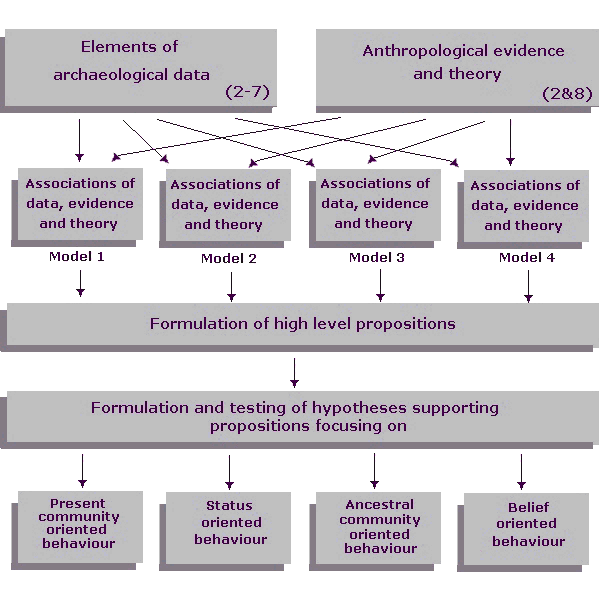
The method employed aims at the partial 'reconstruction of the lifeways' of the sociocultural systems of the periods and areas, but it 'demands the rigorous testing of deductively drawn hypotheses against independent sets of data' (Binford 1968, 13). This is a correct and demanding stipulation. Binford went on to write (1968, 20) that 'high-probability statements covering a broad range of phenomena are the aim of science, not empirical observations which can be destroyed by the citation of a single empirical case to the contrary.' He argued against easy acceptance that not to have all the evidence, or not to know what is undiscovered, is an undue restraint on scientific testing, as is the notion that to depart far from the artefacts themselves increases unreliability of conclusions. He believed that archaeologists are probably trying to measure along several dimensions simultaneously. This is very much the perception of this author based on the research done so far. The individual elements of disposal evidence may have greater or lesser individual importance, or combine or separate in association at different times. However, the warning of Atkinson (1946) that cultures as viewed by anthropologists are not static, but merely present states observed, supports the point that one may neither unquestioningly attribute disposal process meanings for present-day developing cultures to peoples of the Neolithic, Bronze and Iron Ages - nor assume that evidence superficially similar at different times has unchanging meaning, or may not gain or lose associations.
Towards the end of Archaeological Perspectives (Binford and Binford 1968, 24-25), Binford notes that no unit of observation is in form and distribution referable to the operation of a single variable in the past, and that the analytical units by themselves may not be very useful during the final stages of testing. Their relevance is established by reference to the propositions being advanced, and by the theoretical context of those propositions. Morris (1992) makes a related point when he cautions that no single feature of burial evidence can be treated on its own, and believes that religious and social explanations of ritual should be complementary. This section will attempt to work on this broader canvas, and inter-relate features of the evidence.
The general framework for considering the evidence to be adopted for all periods and areas is as follows. The disposal process is treated as the core activity, with its broad phases of pre-disposal, primary disposal, secondary disposal and post-disposal activity. These activities at different points and to different degrees centre on the corpse, the soul and kin, on the social community, on the ancestor community, and on time, space and place (Section 8.3). It has been shown by both ancient and modern anthropological observers that, with the rarest exceptions, the disposal process is directed at more complex purposes that simply disposing of a corpse. This method assumes that the disposal process may interact with foci of society and life and be one medium of expression of beliefs. To these foci the particular stages and forms of disposal process and activity may be directed with meaning. The existence and nature of the purpose stems from the attitude to the disposal process, or in other words from the thoughtful use to which the process is being put by the human agents. The core activity and purposes of the disposal process will therefore be examined for development and change as one of the major rites of passage
This important assumption - that no conscious action or event in the disposal process is likely to be without some purpose - might be challenged on philosophical or practical grounds. This would seem to deny the strength of the probability that conscious human actions have purpose, and certainly go against anthropological evidence worldwide. The problem may be not so much whether to agree to accept that proposition, but rather how to face the assertion of Hawkes (1954, 162) that 'the more human, the less intelligible' as 'the imprint of mind is never unambiguously in the record' (save in rare examples of provable prehistoric cognition, such as systems of measurement).
Section 8 suggested that disposal activity provides many specific links with other contexts of societal behaviour. The most common mentioned there were activities concerned with hierarchical ranking of society, social standing independent of hierarchical rank, community membership (deriving from economic contribution and admitted status), territory, security of the community, well-being and continuity of the community, unity of the community, community perceptions of the nature of the world in which life is lived and how it works, community perceptions of the nature of the otherworld and its inhabitants and how it works, kin group relations, male-female roles and relations, and ethics and the exercise of ethical behaviour. These might be very broadly categorised, following Section 8.7, under the heads of community oriented behaviour related to present peoples and their ancestors (with disposal evidence suggesting action directed towards aggregation activities, fertility, sexuality, disorder, order), status or rank oriented behaviour (use of space, place, and possessions), and belief oriented behaviour (attitudes to types of death, concepts of jeopardy, liminality, space, disorder, order, and so forth).
If disposal activity as a major rite of passage is treated as central core with the phases extending through time, then each of these contexts might be viewed as surrounding it, and as being the subject of interaction with the disposal activity, and interpretable through the medium of the surviving evidence. One type of disposal evidence may support purposes serving several of these contexts, and conversely one context may be supported by several types of disposal evidence. Figure 9.2-1 indicates the general structure to be used in handling the elements of archaeological data, anthropological evidence and theory in relation to the behavioural elements supporting broad behavioural foci:
Figure 9.2-1: The general structure of handling data, evidence and theory

© Internet Archaeology/Author(s)
University of York legal statements | Terms and Conditions
| File last updated: Wed Nov 7 2001